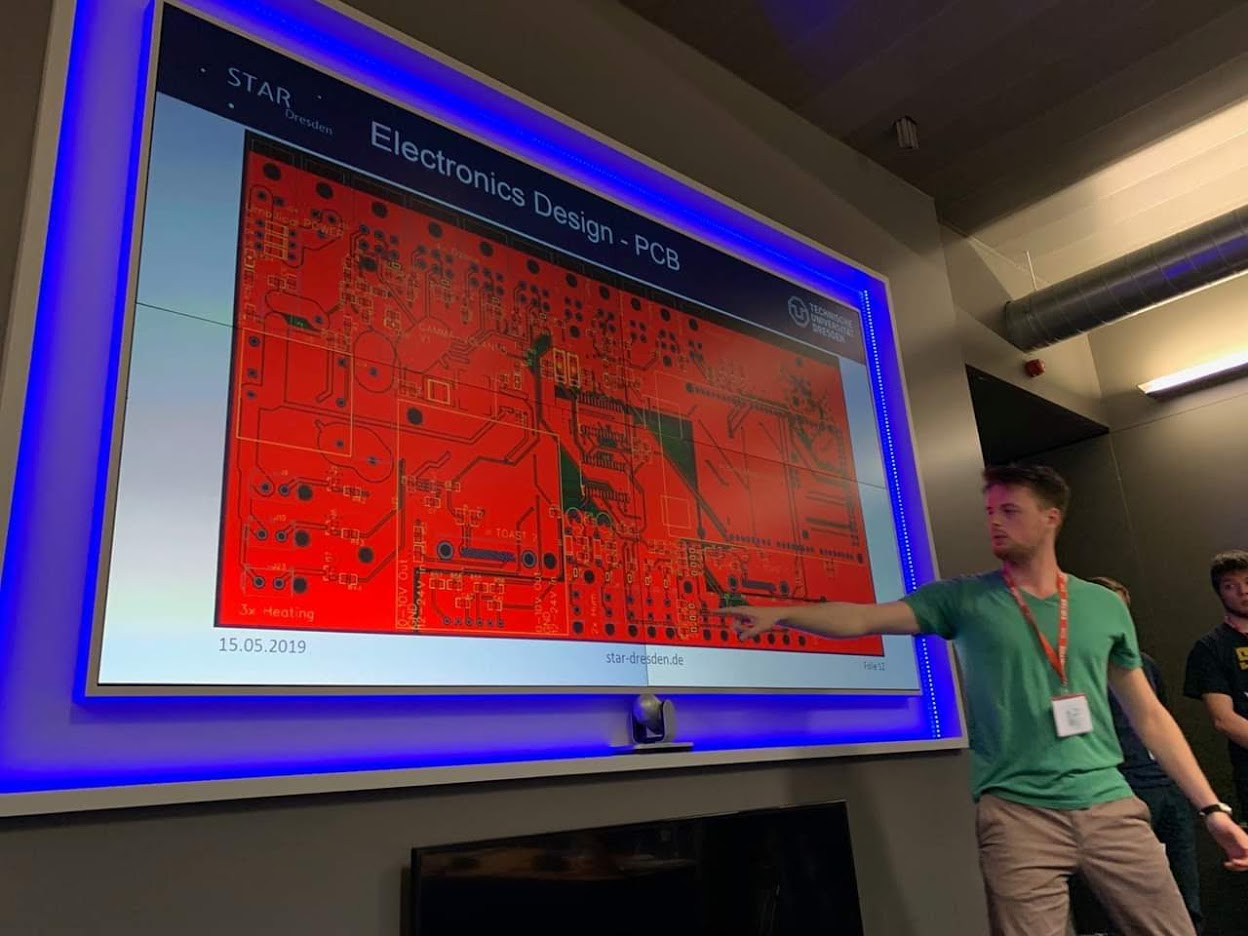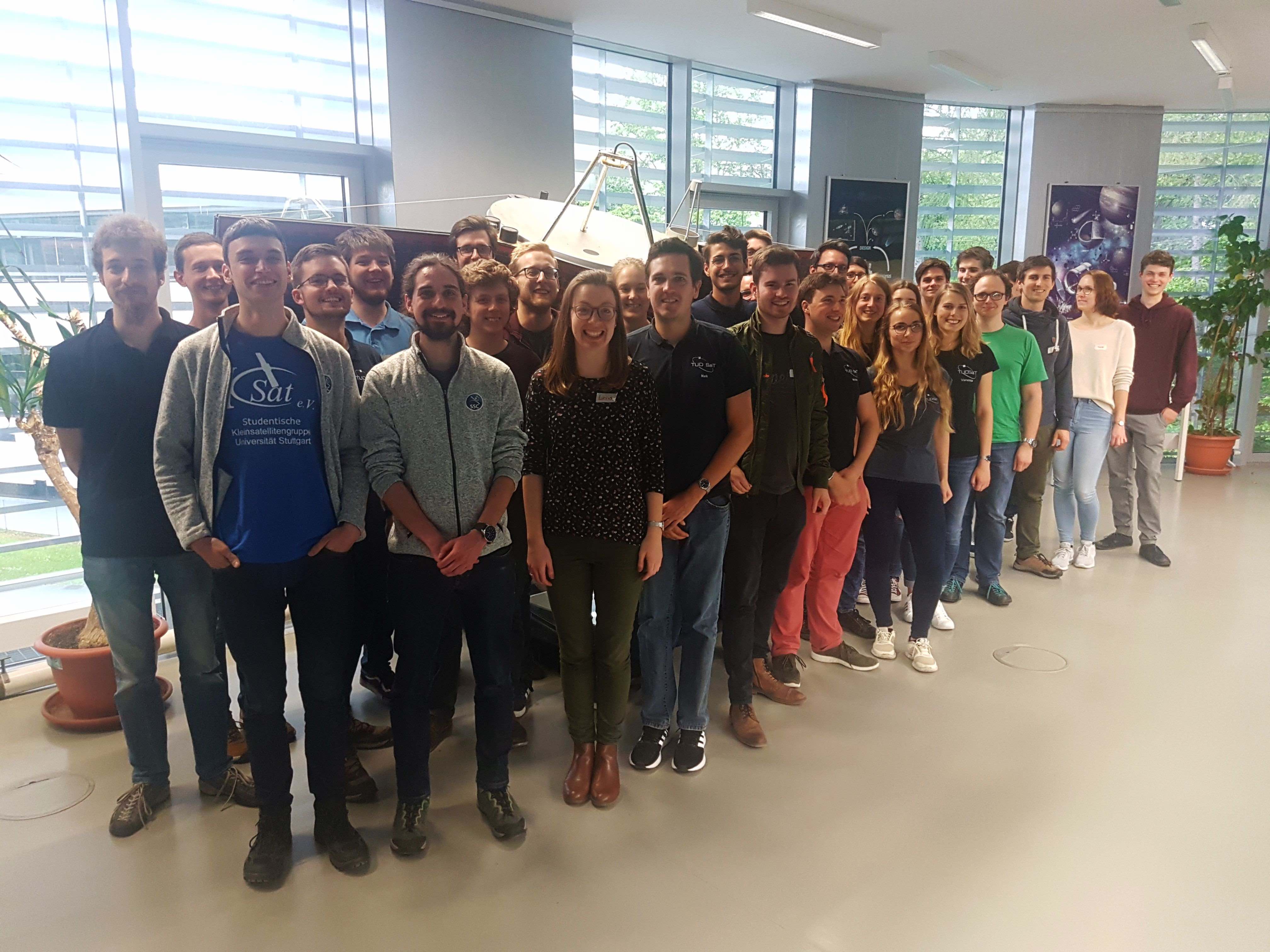BEXUS 28/29 Campaign
The STAR teams OOXYGEN and Gamma-Volantis started the launch campaign for BEXUS 28/29 on October 18th, 2019. 12 of the 15 team members arrived in Kiruna (Sweden) by plane from Dresden and were picked up by bus along with other European teams. After a 45-minute drive we arrived at the Esrange Space Center, in which the Rocket and Balloon launch areas are located and is operated by the Swedish Space Cooperation (SSC). We were in the middle of nowhere, far away from any civilization. Everything was covered in snow and the huge antennas and the Skylark-Tower (which was named after a British sounding rocket, which was launched here several years ago) seemed a bit strange in this beautiful landscape. The buildings, the antennas and the whole area reminded us a bit of a hiding spot for one of the James Bond villains.
During the security briefing at Esrange we learned, that it is absolutely prohibited to take pictures on Esrange, except at the dome, which became basically our second home during the next week. They also warned us about reindeers, which are apparently quite stupid and will run towards your car whenever they get the chance. Unpacking and inventory of our experiment happened at the dome, a huge hangar where thecampaign preparations took place. Additionally, to the dome there was also the Hotel Aurora (the place where all of us were staying), the main building of SSC and some other small buildings.
Saturday morning started off with a lot of troubleshooting, just as the night before. Team OOXYGEN found some major issues in their experiment, which could have led to the failure of the whole experiment. Luckily the electrical engineer and the computer scientist of our team continued working and debugging until a solution was found. Therefore only 13 of our 16 EOS-sensors (experimental oxygen sensors) could stay onboard, but therefore the whole system was able to run. The same night the three remaining members of the OOXYGEN team arrived at Esrange.Gamma-Volantis had the experiment assembly and some test scheduled for the day. The tests were performed to confirm the correct performance of the experiment and to test and calibrate the reference sensor. All components seemed to have survived their journey to Sweden and thankfully everything went smooth.
Troubleshooting lasted the whole next day and on October 21st it was time to set up a sequence for the gondola mounting test. Team OOXYGEN volunteered to be the first experiment, which will be mounted to the gondola BEXUS 28, afterwards it should be Gamma-Volantis turn. In total there would be five experiments mounted on BEXUS 28. Some more problems occurred, and integration got more and more delayed. Gamma-Volantis had connection issues between their ground station and experiment, which could be fixed by one of the friendly SSC members. On BEXUS 28 not only the experiments from Dresden had some difficulties. The Italian team TARDIS from Sapienza University in Rome and the students of team DESTINY from Ecole Polytechnique from Paris had software concerns as well. The Swedish team IRISC from Kiruna had hardware problems, after dropping their Raspberry Pi several times.
The teams whose experiments were mounted to gondola BEXUS 29 had fewer problems. TANOS, SHADE, R2-C2 and IROCS were integrated quite seamlessly and therefore the gondola was ready to launch at the next possible launch window. Launch was set to 6 am on October 23rd and the balloon took off at 6:33 am into the dark sky, which was covered in only a few clouds.
The teams of BEXUS 28 kept working and after a few busy days and night shifts the last screws were set into place on October 23rd on the OOXYGEN experiment. The interference test was scheduled for the same day. All experiments were mounted to the gondola and to detect if any experiment affected the communication of others adversely. The test was completed successfully.
FCT (flight compability testing) was scheduled for the next morning. The test confirmes the communication of ground station and experiment as well as if the experiment is ready to fly. The godola with all experiments was brought to the launch site and it was the first time the experiments were expressed to the true environmental conditions in Sweden. Unfortunately, there was loss of pressure in the nitrogen tank of the OOXYGEN experiment, which let the tank pressure of 150 bars drop within 50 minutes. With the change of the experiment execution this was thankfully not a big problem. The reparation of the lacking tank could have been fixed by tightening a valve, which would only be possible if we dismounted the experiment. If the experiment would have had to be changed and maybe had to be dismounted from the gondola, the FCT with all experiments would have had to be repeated. After FCT there is no touching of the gondola allowed. After FCT the teams had to confirm the flight readiness of their experiments to SSC, ZARM, DLR and ESA. To be ready for the launch at 6 am the next morning, everybody went to bed quite early. The countdown for launch starts 4 hours before launch and the teams had to be at least 30 minutes early at the dome to set up their ground stations.
A bunch of alarms went of at 1 am on October 25th. A few minutes later the team members were on their way to the dome through the freezing cold snow. Four hours countdown went by very quickly, there was always testing and some other small things to do. Around 4 am the late access team was on their way to the balloon to take final measures on the experiments. The night was too foggy for the students to see anything from the dome and the only updateswe got on the launch were rare and via WhatsApp. At 6:22am the BEXUS 28 balloon launched with the experiments OOXYGEN, Gamma-Volantis, DESTINY, IRISC and TARDIS onboard into the dark sky, starting its journey eastwards. Shortly after launch the first data was received by the ground stations. The OOXYGEN experiment began the measurement cycles as expected and at the first glimpse Gamma-Volantis looked promising as well. After a while a failure of the GV sensors occurred and caused some low spirits. After 3 hours flight time the gondola was released from the balloon and started the journey back to the earth’s surface with a parachute.
A lot of teams were disappointed, because not everything with the experiments went according to plan. Simon Mawn from ZARM (one of the payload managers) held a little motivational speech and complimented all of us to have launched an experiment into the stratosphere. This brought back the thoughts that a working experiment was not the whole purpose of all of our work, but to be able to make it to the point, where we are able to launch an experiment into the stratosphere. Of course, everybody wanted their experiment to work, but we can learn from our mistakes and are able to avoid them next time. We were able to take part in a BEXUS campaign which launched a balloon to up to 27000 meters and learneda lot of lessons.

The same night SSC organized a campaign dinner with some entertainment provided by each team. We celebrated the launch of our experiments with delicious food, cheerfulness and a lot of very expensive Swedish alcohol...
On Saturday (October 26th) almost everybody slept till noon. We were awake more than 24h for the launch, campaign dinner and the afterparty and desperately needed some sleep. Some of us planned to do a little hike through the beautiful area, but those plans were canceled due to a short notice guided tour to the rocket launch pad. The same day there was a failed recovery attempt for the BEXUS 28 gondola, due to heavy snow and clouds in Finland. During another team meeting the recovery was scheduled for Monday. Therefore, one team member had to stay in Sweden for the dismounting of the experiment.
At 4 am on Sunday (October 28th) the bus took us to the airport in Kiruna, where all the teams took a plane to get back home.
Back in Dresden we are waiting for the onboard data of the experiment to the final evaluation of the sensor data. BEXUS was a great and once (maybe and hopefully twice) in a lifetime experience, which let our teams grow together and gave us the chance to gain a lot of new skills.
We really want to thank Simon, Dieter, Stefan, Kathi, Alex, Rodrigo, Paolo, Michael, Arthur, the people from Esrange, from the Center of Applied Space Technology and Microgravity (ZARM), from the German Aerospace Center (DLR), from the Swedish Space Corporation (SSC), from the Swedish National Space Agency (SNSA) and from the European Space Agency (ESA). And we were proud to fly with all the other teams!
Per aspera ad astra – Seneca
Text: Benedikt Boos

















